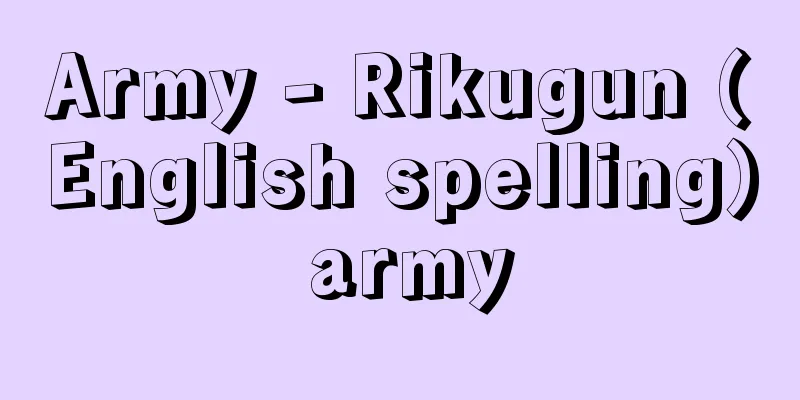Army - Rikugun (English spelling) army

|
The branch of the military responsible for most military operations on land. It also handles coastal and strait defense and sea transportation. Ground combat is also conducted by the Marines. The Army's mission is to destroy enemy ground forces and secure the occupation of territories, while also playing a role in controlling the population. Furthermore, within the country, it complements the police as the ultimate armed force supporting the government. The armies that emerged in ancient nations were the prototype of land armies. Swords, spears, bows and arrows, which were born as tools for life and production in primitive societies, came to be used in wars over regional domination and the acquisition of slaves. Powerful ancient nations established standing armies made up of cavalry and infantry, and fought large-scale wars of plunder. From the 14th century onwards, with the development of rifles and cannons, the emphasis shifted to organised firepower combat, and infantry overwhelmed the knights. The creation of the National Army during the French Revolution marked the beginning of the modern army. Napoleon's development of annihilation strategies that made full use of firepower and mobility paved the way for modern warfare. Many countries imposed military service obligations on the general population and came to have large standing armies. The army, which forms the core of these armies, adopted the divisional structure from the 18th century onwards, perfecting the tactical integration of the three branches of the military: infantry, artillery and cavalry. Divisions also gained the ability to operate independently by having a variety of supporting branches, enabling them to operate for long periods of time far from home. Machine guns, which were widely used in the Russo-Japanese War, increased the superiority of infantry in position defense, but tanks appeared in World War I and have since become the main players on the battlefield due to their striking power, mobility, and defensive capabilities. Tank crews, artillerymen, and infantry replaced cavalry as the main branches of the army. On the other hand, the navy developed from the 19th century, and in the 20th century, aircraft appeared and aviation power became important. As a result, operations became more multi-dimensional, and integrated operations of land, sea, and air became essential. In World War II, extensive and fierce battles were fought for a long period of time, and the battlefields spread across the entire territories of the warring countries. Nuclear weapons and missiles, which appeared at the end of the war, have been further developed since then, and have fundamentally changed the nature of ground warfare. The armies of nuclear powers such as the United States and the former Soviet Union are equipped with nuclear weapons as the core of their striking power, and also have aviation corps, and have prepared for integrated air and ground operations. In addition, artillery firepower has focused on missiles, and has been differentiated into branches with anti-aircraft, anti-tank, and ground attack missions according to their functions. The modern Japanese army began in 1871 (Meiji 4) with the organization of the Goshimpei as a military force directly under the Emperor. In the same year, garrisons were established for the purpose of suppressing civil unrest, and the conscription law was enacted in January 1873. In the military reform of 1888, the garrisons were abolished and divisions were formed. Thus, having prepared for continental operations, Japan fought and won the Sino-Japanese War and the Russo-Japanese War. In 1907 (Meiji 40), it designated Russia, America, and France as potential enemies and established the "Imperial National Defense Policy" based on an external offensive strategy. It set 40 army divisions as the required military strength in wartime, and promoted the expansion of its military. After the Manchurian Incident in 1931 (Showa 6), it expanded its war of aggression to China and Southeast Asia, and entered the Pacific War, only to suffer a complete defeat in August 1945 (Showa 20). At that time, the army's military strength was 6.4 million. As a result of Japan's defeat in the war, the Army and Navy were disbanded. However, on July 8, 1950, the Supreme Commander for the Allied Powers ordered the establishment of the National Police Reserve, which later became the National Safety Forces and was reorganized into the Ground Self-Defense Forces in 1954, effectively restoring the Army. As of 1997, the Army has a total manpower of 180,000, approximately 1,130 tanks, and approximately 6,000 artillery pieces, and the quality of its standard equipment is among the highest in the world. Looking at the world's ground forces, the rankings in terms of troop strength (units in parentheses are 10,000) are China (220), North Korea (100), India (98), South Korea (54.8), and Turkey (52.5), but in terms of quality, the United States stands out in 8th place. In 9th place is Russia. The U.S. Army has 490,000 troops, about 15,000 main battle tanks, and about 14,000 artillery pieces, and is organized into 10 divisions: armored divisions, mechanized divisions, infantry divisions, light infantry divisions, airborne assault divisions, and airborne divisions. Two of these divisions are stationed in Europe and one in South Korea. The Soviet ground forces peaked at 2 million in 1987, but today Russia's has shrunk to 460,000. The budget is small, with most of it being spent on personnel and accommodation costs, and weapons purchases have been greatly reduced. (Data current as of 1996.) [Haruo Fujii] [Reference items] | | | |Source: Shogakukan Encyclopedia Nipponica About Encyclopedia Nipponica Information | Legend |
|
陸上における軍事行動の大部分を担任する軍種。沿岸、海峡の防御や海上輸送にあたることもある。地上戦闘は海兵隊によっても行われる。 陸軍の任務は、敵地上部隊の破砕と地域の占領確保にあり、あわせて住民支配の役割をも担う。また国内においては、権力を支える最終的実力組織として、警察を補完する。 古代国家において発生した軍隊は、陸軍の原型であった。原始社会で生活と生産の用具として生まれた刀や槍(やり)、弓矢などが地域の支配や奴隷の獲得をめぐる戦争に使われるようになった。古代の強国は、騎兵や歩兵からなる常備の軍隊を設け、大規模な略奪戦争を行った。 14世紀以降、小銃と大砲が発達するに伴い、組織的な火力戦闘が重視されるようになり、歩兵隊が騎士団を圧倒した。フランス革命における国民軍の創設は、近代陸軍の始まりであった。またナポレオンによる火力、機動力を駆使した殲滅(せんめつ)戦略の展開は、近代戦争に道を開いた。 多くの国が一般国民に兵役義務を課し、大規模な常備軍をもつようになった。その中心をなす陸軍は、18世紀以降、師団編成を採用し、歩兵、砲兵、騎兵の3兵科を統合的に運用する戦術が完成した。師団はまた多様な支援兵科をもつことにより、独立して作戦する能力を得て、遠く国外において長期にわたり活動できるようになった。 日露戦争で本格的に使用された機関銃は、歩兵による陣地防御の優位性を高めたが、第一次世界大戦で戦車が出現、その打撃力、機動力、防護力をもって以後、戦場の主役となっている。騎兵にかわる戦車兵と砲兵、歩兵が陸軍の主力兵科となったのである。 一方、19世紀から海軍が発展し、20世紀に入ると航空機が登場して航空兵力が重視されることになった。これにより作戦は立体化し、陸海空の統合運用が不可欠とされている。第二次大戦では広範かつ激烈な戦闘が長期にわたって戦われ、戦場は交戦国国土の全域に及んだ。 大戦末に出現した核兵器とミサイルは、その後ますます発展し、地上戦の様相を根本的に変えた。アメリカ、旧ソ連など核大国の陸軍は打撃力の中軸として核兵器を装備し、さらに航空兵科をもち、空地一体の作戦態勢を整えていた。また砲兵火力はミサイルに重点を置き、その機能によって対空、対戦車、対地攻撃を任務とする兵科に分化してきている。 近代日本の陸軍は1871年(明治4)天皇直属の軍隊として御親兵が組織されたところに始まる。同年、内乱鎮圧を目的とする鎮台が設置され、73年1月には徴兵令が施行された。88年の軍制改革により鎮台が廃止されて師団が編成された。 こうして大陸作戦の準備を整えて日清(にっしん)戦争、日露戦争を戦い、これに勝利した。1907年(明治40)にはロシア、アメリカ、フランスを仮想敵国とし、対外攻勢戦略にたつ「帝国国防方針」を定め、陸軍40個師団が戦時所要兵力量として設定され、軍備の充実を進めた。1931年(昭和6)の満州事変以降、中国、東南アジアへ侵略戦争を拡大し、太平洋戦争に突入したが、45年(昭和20)8月ついに完全な敗北に至った。当時の陸軍兵力は640万人であった。 敗戦の結果、陸海軍は解体された。だが1950年7月8日付け連合国軍最高司令官の指令により、警察予備隊が設置され、その後保安隊を経て54年陸上自衛隊に改編され、事実上の陸軍が復活した。97年現在の定員は18万人、戦車約1130両、火砲約6000門をもち、通常装備の質は世界の最高水準にある。 世界の陸軍をみると兵力数(カッコ内単位万人)の順位は中国(220)、北朝鮮(100)、インド(98)、韓国(54.8)、トルコ(52.5)となっているが、質的には8位のアメリカが突出している。9位はロシアである。 アメリカ陸軍は兵力49万人、主力戦車約1万5000両、火砲約1万4000門をもち、機甲師団、機械化師団、歩兵師団、軽歩兵師団、空中強襲師団、空挺師団の計10個師団に編成されている。うち2個師団がヨーロッパに、1個師団が韓国に駐留する。 ソ連の地上軍はピークの1987年に200万人を保有していたが、現在のロシアは46万人へと激減している。予算は少なく、その大半は人件費、宿舎費にあてられており、兵器購入費は大幅に縮小されている。(データは1996年現在)。 [藤井治夫] [参照項目] | | | |出典 小学館 日本大百科全書(ニッポニカ)日本大百科全書(ニッポニカ)について 情報 | 凡例 |
Recommend
Ulm Cathedral - Ulmer Münster
Ulm Cathedral in the state of Baden-Württemberg in...
《Sepher ha-Zohar》(English spelling)Sepher haZohar
…The correct name is Sepher ha-Zohar. It is the f...
Ueki Emori - Plants and Branches
A thinker and advocate of freedom and civil right...
Kimoto-so - Kinomoto-no-sho
...The lord of the manor would prepare the ponds ...
Ship of Fools (Porter)
…After that, he mainly used short stories as his ...
pishtaq (English spelling)
…In the cooler, more rainy climates of Anatolia, ...
provisioning
…The first time animals were fed was in 1952 on K...
Schott, G. (English spelling) SchottG
…Lycosthenes’ Chronicles of Omens and Demonstrati...
Meteorologica (English spelling)
...This is because (1) the composition of the atm...
MITRE Corp.
… [Technology Assessment Methodology] There is no...
Ukufu - Ukufu
...Pilgrims, clad in two seamless white cloths (i...
Anglo‐Saxon - Anglo‐Saxon (English spelling)
Another name for Old English (OE). A variety of Lo...
Polymer catalyst
Polymers with catalytic properties. Catalysts are ...
Greater Sparrow - Greater Sparrow
A moth belonging to the order Lepidoptera and the...
X-ray photoelectron spectroscopy
...The method that uses light irradiation is call...









![Malaita [island] - Malaita](/upload/images/67ccea9751838.webp)